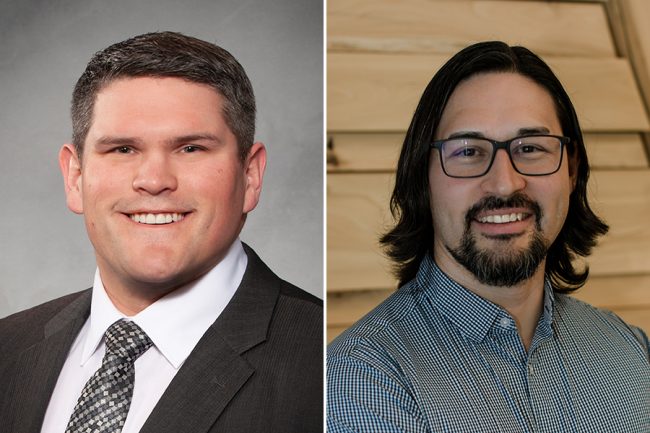
On November 12, faculty, staff and students from across U of T Engineering will have the opportunity to learn more about the connections between engineering and Indigenous Peoples.
The talk, titled ‘Indigenous Engineering Design, Ethics, and Role Models‘, will be given by professional engineers John Desjarlais and Matthew Dunn, co-presidents of the Saskatchewan Professional Chapter of the Canadian Indigenous Science and Engineering Society. It is being held as part of the Towards Inclusive Practices Series (TIPS) hosted by U of T’s Engineering Equity, Diversity, and Inclusion Action Group.
Writer Tyler Irving connected with Dunn and Desjarlais by email to learn more.
__
Can you share a bit about your own background, and how you realized that engineering was for you?
John Desjarlais
I was raised in a rich Nehinaw/Metis culture in a relatively small remote northern Saskatchewan community, Cumberland House, which is situated in the heart of the Saskatchewan River Delta. My surroundings and culture very much influenced where I am today, and my choice of engineering as a profession.
I was naturally interested in mechanics or the physics of the world around me — what made the boats we used faster, why canoes floated, and how to improve on snowmobiles and other things around us.
I was also aware of engineering as a profession since my father had direct experience working with many engineers in a resource development economy. But I didn’t realize it was for me or what it actually was until I spent time working in and around the profession myself, as a radiation/safety/environment technician for Cameco from 2001 to 2006. That is when I learned I wanted to become an engineer.
Matthew Dunn
Growing up I had the childhood dream of becoming an astronaut, and in Grade 9 I heard about the option of aerospace engineering as a career path for the first time.
I had always done well in school, especially in math and the sciences, and engineering seemed like a great option for me. I studied mechanical engineering at university and obtained my undergraduate and master’s degrees at the University of Saskatchewan.
Life took me down a very different path from aerospace engineering. I ended up working in the mining industry for over six years before switching career paths to working at the University of Saskatchewan for the past seven years in the area of Indigenous inclusion.
How do you approach design and ethics from an Indigenous perspective?
Matthew Dunn
There are many examples of Indigenous engineering design from history that, unfortunately, not everyone is aware of.
Our talk presents a handful of these designs, such as the Travois, a structure for transporting goods, and the Bull Boat, used for river transport.
John Desjarlais
Design and ethics are typically taught from a western and colonial perspective, whereas Indigenous design and ethics demonstrate integration and historical examples of problem-solving using a reciprocity and virtue-based mindset.
Two important Cree concepts are Mino Pimatisiwin and Mino-Pimachisowin, which are the ideas of the good life and the ability to live a good life, respectively. In this case, “good” is a holistic concept inclusive of many more dimensions than just our material world. The concepts are very analogous to teachings of living a good life across other Indigenous language groups as well.
These concepts influence my practice through a deeper relationship with ethics built on a virtue-based or ethics-of-character system. My practice is influenced by my desire to be a good person, which is how I achieve Mino-Pimatisiwin — the good life.
Why is it important for the U of T Engineering community to hear more about these positive connections?
Matthew Dunn
In order to support reconciliation in this country, the engineering profession needs to be proactive about building and maintaining respectful relationships with Indigenous peoples and communities. Learning more about Indigenous engineering design and ethics can be a starting point for discussions that ultimately lead to positive actions in this area.
By highlighting Indigenous engineering role models in this talk, we hope that more Indigenous students will see themselves as engineers. Another outcome that we’d like to see among non-Indigenous students and professionals is the shift from a deficit mindset to an asset mindset when it comes to Indigenous Peoples’ participation in engineering.
John Desjarlais
It is important for everyone to see how engineering is not a western construct, but a global reflection of different groups’ desires to solve problems and create solutions for better societal outcomes.
I hope our talk will inspire ideas of humility and expand on how we see engineering education and design. We hope to increase awareness of Indigenous involvement in engineering, and to help our audience see value in adding Indigenous worldviews to engineering practice.
U of T Engineering faculty, staff and students can register for the talk, which will take place virtually on November 12.
– This story was originally published on the University of Toronto’s Faculty of Applied Science and Engineering News Site on November 5, 2021 by Tyler Irving